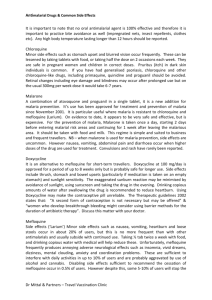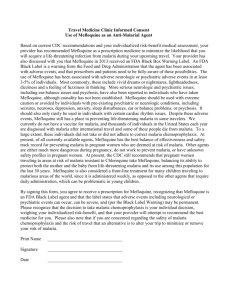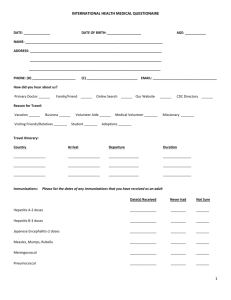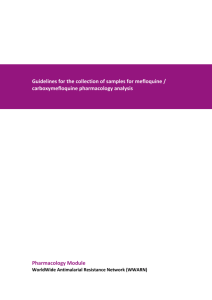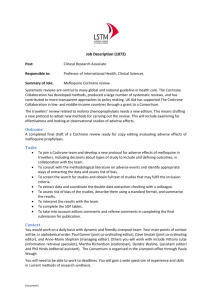Identification of ( Mycobacterium avium Infection in Mice )-Erythro-Mefloquine as an Active Enantiomer
advertisement
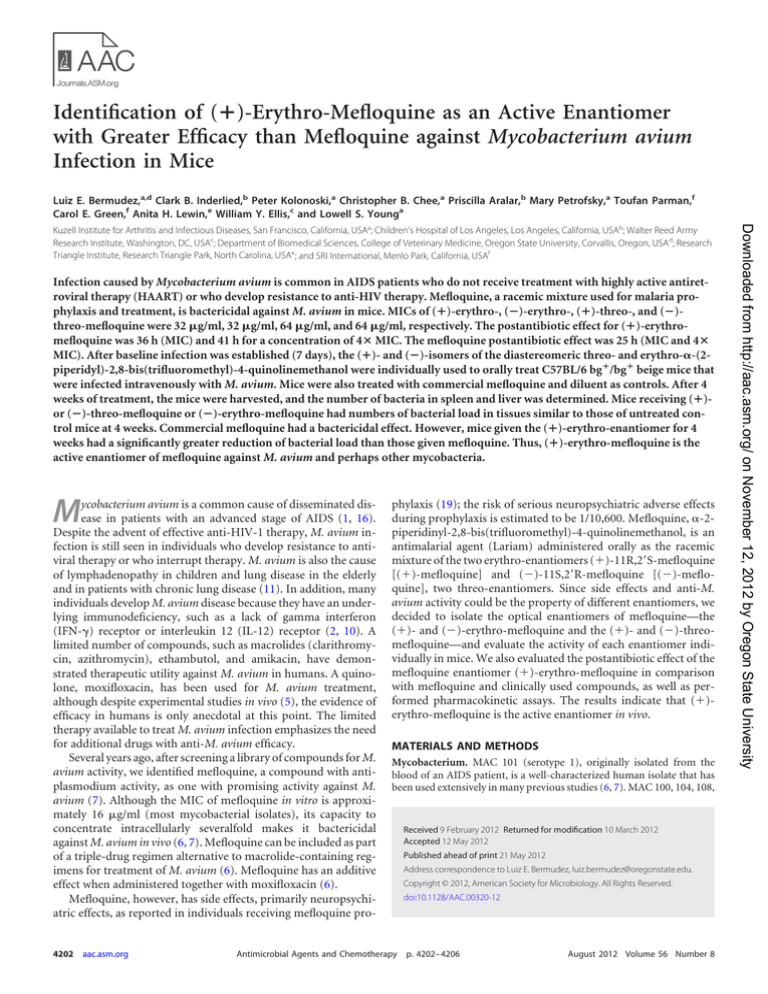
Identification of (ⴙ)-Erythro-Mefloquine as an Active Enantiomer with Greater Efficacy than Mefloquine against Mycobacterium avium Infection in Mice Luiz E. Bermudez,a,d Clark B. Inderlied,b Peter Kolonoski,a Christopher B. Chee,a Priscilla Aralar,b Mary Petrofsky,a Toufan Parman,f Carol E. Green,f Anita H. Lewin,e William Y. Ellis,c and Lowell S. Younga Infection caused by Mycobacterium avium is common in AIDS patients who do not receive treatment with highly active antiretroviral therapy (HAART) or who develop resistance to anti-HIV therapy. Mefloquine, a racemic mixture used for malaria prophylaxis and treatment, is bactericidal against M. avium in mice. MICs of (ⴙ)-erythro-, (ⴚ)-erythro-, (ⴙ)-threo-, and (ⴚ)threo-mefloquine were 32 g/ml, 32 g/ml, 64 g/ml, and 64 g/ml, respectively. The postantibiotic effect for (ⴙ)-erythromefloquine was 36 h (MIC) and 41 h for a concentration of 4ⴛ MIC. The mefloquine postantibiotic effect was 25 h (MIC and 4ⴛ MIC). After baseline infection was established (7 days), the (ⴙ)- and (ⴚ)-isomers of the diastereomeric threo- and erythro-␣-(2piperidyl)-2,8-bis(trifluoromethyl)-4-quinolinemethanol were individually used to orally treat C57BL/6 bgⴙ/bgⴙ beige mice that were infected intravenously with M. avium. Mice were also treated with commercial mefloquine and diluent as controls. After 4 weeks of treatment, the mice were harvested, and the number of bacteria in spleen and liver was determined. Mice receiving (ⴙ)or (ⴚ)-threo-mefloquine or (ⴚ)-erythro-mefloquine had numbers of bacterial load in tissues similar to those of untreated control mice at 4 weeks. Commercial mefloquine had a bactericidal effect. However, mice given the (ⴙ)-erythro-enantiomer for 4 weeks had a significantly greater reduction of bacterial load than those given mefloquine. Thus, (ⴙ)-erythro-mefloquine is the active enantiomer of mefloquine against M. avium and perhaps other mycobacteria. M ycobacterium avium is a common cause of disseminated disease in patients with an advanced stage of AIDS (1, 16). Despite the advent of effective anti-HIV-1 therapy, M. avium infection is still seen in individuals who develop resistance to antiviral therapy or who interrupt therapy. M. avium is also the cause of lymphadenopathy in children and lung disease in the elderly and in patients with chronic lung disease (11). In addition, many individuals develop M. avium disease because they have an underlying immunodeficiency, such as a lack of gamma interferon (IFN-␥) receptor or interleukin 12 (IL-12) receptor (2, 10). A limited number of compounds, such as macrolides (clarithromycin, azithromycin), ethambutol, and amikacin, have demonstrated therapeutic utility against M. avium in humans. A quinolone, moxifloxacin, has been used for M. avium treatment, although despite experimental studies in vivo (5), the evidence of efficacy in humans is only anecdotal at this point. The limited therapy available to treat M. avium infection emphasizes the need for additional drugs with anti-M. avium efficacy. Several years ago, after screening a library of compounds for M. avium activity, we identified mefloquine, a compound with antiplasmodium activity, as one with promising activity against M. avium (7). Although the MIC of mefloquine in vitro is approximately 16 g/ml (most mycobacterial isolates), its capacity to concentrate intracellularly severalfold makes it bactericidal against M. avium in vivo (6, 7). Mefloquine can be included as part of a triple-drug regimen alternative to macrolide-containing regimens for treatment of M. avium (6). Mefloquine has an additive effect when administered together with moxifloxacin (6). Mefloquine, however, has side effects, primarily neuropsychiatric effects, as reported in individuals receiving mefloquine pro- 4202 aac.asm.org phylaxis (19); the risk of serious neuropsychiatric adverse effects during prophylaxis is estimated to be 1/10,600. Mefloquine, ␣-2piperidinyl-2,8-bis(trifluoromethyl)-4-quinolinemethanol, is an antimalarial agent (Lariam) administered orally as the racemic mixture of the two erythro-enantiomers (⫹)-11R,2=S-mefloquine [(⫹)-mefloquine] and (⫺)-11S,2=R-mefloquine [(⫺)-mefloquine], two threo-enantiomers. Since side effects and anti-M. avium activity could be the property of different enantiomers, we decided to isolate the optical enantiomers of mefloquine—the (⫹)- and (⫺)-erythro-mefloquine and the (⫹)- and (⫺)-threomefloquine—and evaluate the activity of each enantiomer individually in mice. We also evaluated the postantibiotic effect of the mefloquine enantiomer (⫹)-erythro-mefloquine in comparison with mefloquine and clinically used compounds, as well as performed pharmacokinetic assays. The results indicate that (⫹)erythro-mefloquine is the active enantiomer in vivo. MATERIALS AND METHODS Mycobacterium. MAC 101 (serotype 1), originally isolated from the blood of an AIDS patient, is a well-characterized human isolate that has been used extensively in many previous studies (6, 7). MAC 100, 104, 108, Antimicrobial Agents and Chemotherapy Received 9 February 2012 Returned for modification 10 March 2012 Accepted 12 May 2012 Published ahead of print 21 May 2012 Address correspondence to Luiz E. Bermudez, luiz.bermudez@oregonstate.edu. Copyright © 2012, American Society for Microbiology. All Rights Reserved. doi:10.1128/AAC.00320-12 p. 4202– 4206 August 2012 Volume 56 Number 8 Downloaded from http://aac.asm.org/ on November 12, 2012 by Oregon State University Kuzell Institute for Arthritis and Infectious Diseases, San Francisco, California, USAa; Children’s Hospital of Los Angeles, Los Angeles, California, USAb; Walter Reed Army Research Institute, Washington, DC, USAc; Department of Biomedical Sciences, College of Veterinary Medicine, Oregon State University, Corvallis, Oregon, USAd; Research Triangle Institute, Research Triangle Park, North Carolina, USAe; and SRI International, Menlo Park, California, USAf (⫹)-Erythro-Mefloquine against Mycobacterium avium August 2012 Volume 56 Number 8 TABLE 1 MICs of 50% and 90% were determined using 30 strains for M. avium, including 6 strains that are resistant to clarithromycin MIC Compound 50% 90% (⫹)-Erythro-mefloquine (⫺)-Erythro-mefloquine (⫹)-Threo-mefloquine (⫺)-Threo-mefloquine Mefloquine Clarithromycin Moxifloxacin 32 32 32 64 16 2 0.5 32 32 64 64 16 4 0.5 5 days after oral administration. Blood was also obtained from control, untreated mice. Between 18 and 21 mice were used per drug for each time point. Collected blood was frozen until analysis by high-performance liquid chromatography (HPLC). One hundred microliters of thawed blood samples or calibration standards received 20 l of internal standard solution (see Table 3), followed by 100 l of 0.2 N NaOH. Mefloquine analogs were extracted from the blood with 1,000 l methyl t-butyl ether (MTBE). The organic layers were removed, and the MTBE was evaporated. Mefloquine derivatives in the resulting dry residues were derivatized by the addition of 125 l of 0.4 mM (⫺)-1-(9-fluorenyl)ethyl chloroformate (FLEC) diluted in acetonitrile and 50 l of 15 mM sodium borate buffer, pH 8.5, to form a fluorescent derivative of these analytes. The mixtures were incubated at room temperature for 40 min and then clarified by centrifuging for 5 min before being transferred to HPLC vials fitted with glass inserts for HPLC analysis. Mefloquine, (⫹)-erythro, (⫺)-erythro, (⫹)-threo, and (⫺)-threo were assayed using (⫺)-threo, (⫺)-erythro, (⫹)-erythro, (⫺)-threo, and (⫹)-threo, respectively, as internal controls. The mefloquine analogs were separated by HPLC, using a C18 column (Luna C18 [2], 4.6 by 250 mm, from Phenomenex, Torrance, CA) maintained at room temperature. Elution of the analogs was achieved isocratically with 74% acetonitrile-26% water (vol/vol) containing 0.1% formic acid at a flow rate of 1 ml/min for a total run time of 40 min. The autosampler temperature was controlled at 10°C. Injection volumes of all samples and standards were 20 l. Chromatography was monitored by fluorescence with excitation at 265 nm and emission at 475 nm, and under these conditions the retention times were ⬃25.5, 32, 30, and 27 min for (⫹)erythro-mefloquine, (⫺)-erythro-mefloquine, (⫹)-threo-mefloquine, and (⫺)-threo-mefloquine, respectively. Study samples were processed in parallel with a set of calibration standards (run in triplicate) prepared in blank mouse blood at concentrations of 0.05, 0.10, 0.50, 1.00, 5.00, and 10.00 g/ml. Calibration standard curves for each mefloquine analog were prepared by performing weighted (1/y) linear regression of the peak-height ratios (analog/internal standard) versus concentration. All of the experimental calibration curves yielded coefficient of determination (r2) values of 0.985 or greater. Statistical analysis. The statistical significance of the differences in tissue bacterial loads was assessed by analysis of variance (ANOVA). Differences between experimental groups were considered significant at P values of ⬍0.05. RESULTS Table 1 shows that the four mefloquine enantiomers had comparable MICs in vitro against M. avium strains. The MIC was also similar to the MIC obtained with mefloquine. Therefore, when one adds bacterium and compound to a test device, the racemic mixture and enantiomers behave similarly. The postantibiotic effect (PAE) of (⫹)-erythro-mefloquine against three MAC isolates, however, was significantly greater than that of mefloquine both at the MIC and 4⫻ MIC (Table 2). In aac.asm.org 4203 Downloaded from http://aac.asm.org/ on November 12, 2012 by Oregon State University 109, and 116 were also isolated from the blood of AIDS patients and belong to serotypes 8, 1, 1, 4, and 1, respectively. M. avium organisms were cultured on Middlebrook 7H11 agar (Difco, Detroit, MI) supplemented with oleic acid, albumin, dextrose, and catalase for 10 days at 37°C. For the infection of mice, transparent colony morphotypes were harvested and resuspended in Hank’s buffered salt solution (HBSS) and adjusted to a concentration of 3 ⫻ 108 CFU/ml by using a McFarland standard (5, 6). The number of bacteria in the inoculum was confirmed by colony plating onto 7H11 agar. Thirty clinical isolates, including MAC 100, 104, 108, 109, and 116, were used for the MIC assay. Six of the isolates were resistant to clarithromycin. Antibiotics. The racemic mixture of mefloquine was provided by the Walter Reed Army Institute for Research. Racemic mefloquine hydrochloride was resolved using the ammonium salt of (⫹)-3-bromo-8-camphorsulphuric acid to afford (⫺)-erythro-mefloquine, as previously described (9). In an analogous fashion, (⫹)-erythro-mefloquine was obtained using the ammonium salt of (⫺)-3-bromo-8-camphorsulphuric acid. Each of the erythro-enantiomers was epimerized to the corresponding threo-enantiomer by treatment of each N-acetyl derivative with thionyl chloride as reported previously (9). The erythro and threo-enantiomers of mefloquine were provided by the Walter Reed Army Institute of Research under NIAID contract N01-AI-5402. In vitro testing. MICs were performed by a radiometric broth macrodilution method and the T100 method of data analysis (15). The inoculum was prepared as previously reported (15). It was placed into 7H9 broth and frozen at ⫺70°C. The bacterial concentration was adjusted to approximately 5 ⫻ 104 CFU/ml as previously described (15). Controls included the inoculum undiluted without adding drug, the inoculum diluted 1:100 (99% control), and the inoculum diluted 1:1,000 (99.9% control). The period of observation and the endpoint were determined by daily monitoring of the control and test cultures. Seven days was sufficient time for the isolates. Postantibiotic effect. The postantibiotic effect of mefloquine, enantiomers, clarithromycin, and moxifloxacin was determined as previously described (8) against the strains MAC 101, MAC 104, and MAC 109. The postantibiotic effect for mefloquine, as well as that for (⫹)-erythro-mefloquine, was identified in parallel to the postantibiotic effect of clarithromycin and moxifloxacin, using the MIC and 4⫻ MIC. Mouse studies. C57BL/6J-Lystbj-J/Lystbj-J female mice, age 8 to 10 weeks, were obtained from Jackson Laboratories for challenge studies. Mice were infected through the caudal vein with 3 ⫻ 107 CFU of MAC 101 in a volume of 0.1 ml. After 7 days, treatment was initiated with mefloquine, (⫹)-erythro-mefloquine, (⫺)-erythro-mefloquine, (⫹)-threomefloquine, or (⫺)-threo-mefloquine at 40 mg/kg of body weight/day as oral monotherapy. The dose was determined based on a previous study that evaluated the dose-response activity of mefloquine (7). Each drug treatment group in each experiment contained at least 12 animals. Control groups, also with 12 animals each, received the drug vehicle only. In addition, an experimental group of at least five mice was harvested after 7 days of infection, in order to establish a baseline level of infection in tissues. Mice received treatment for 4 weeks and were then euthanized after a period of 48 h without receiving therapy. Livers and spleens of all mice were aseptically dissected, weighed, and homogenized in 5 ml of Middlebrook 7H9 broth (Difco) containing 20% glycerol, as previously described (6, 7). Tissue suspensions were serially diluted and plated onto Middlebrook 7H11 agar plates to determine the number of viable organisms. Plates were incubated at 37°C for 10 days. Bactericidal effect was defined as the bacterial load at the end of the experiment being smaller than the bacterial load at day seven, before treatment was initiated. Blood drug levels. Blood concentrations were determined after a single-dose oral administration of 10 mg/kg of mefloquine and each of the enantiomers, (⫹)-erythro, (⫺)-erythro, (⫹)-threo, and (⫺)-threo to BALB/c mice. Blood was collected from the retro-orbital sinus into tubes containing EDTA at 10 min, 30 min, 1 h, 2 h, 4 h, 8 h, 12 h, 24 h, 3 days, and Bermudez et al. TABLE 2 PAE was measured at MIC and 4⫻ MIC of drug with an exposure time of 24 h PAE (h; mean ⫾ SD)a MIC 4⫻ MIC (⫹)-Erythro-mefloquine (⫺)-Erythro-mefloquine (⫹)-Threo-mefloquine (⫺)-Threo-mefloquine Mefloquine Clarithromycin Moxifloxacin 36 ⫾ 2 ND ND ND 25 ⫾ 1 28 ⫾ 4 2 ⫾ 0.5 41 ⫾ 3 ND ND ND 25 ⫾ 2 42 ⫾ 3 2⫾1 a Against the strains MAC 101, MAC 104, and MAC 109. ND, not done. comparison, (⫹)-erythro-mefloquine had greater PAE than clarithromycin at the MIC, but the PAE was similar when bacteria were exposed to the concentration of 4⫻ MIC. Moxifloxacin had PAE of 2 h independent of the concentration used. After intravenous administration, the half-lives (t1/2) for mefloquine, (⫹)-erythro, and (⫺)-erythro-enantiomers were similar: 17.8 h, 16.7 h, and 20.6 h, respectively. The two threo-enantiomers were both eliminated more rapidly than the parent compound and the erythro-enantiomers. The t½ for (⫹)-threoand (⫺)-threo-enantiomers were 12.4 h and 11 h, respectively. Following oral administration, the t1/2 were 16.3 h, 20.8 h, and 16.4 h for mefloquine, (⫹)-erythro, and (⫺)-erythro-mefloquine, respectively. After oral administration, the Cmax of mefloquine was lower than the individual Cmax values of (⫹)-erythro- and (⫺)-erythro-enantiomers. The area under the curve (AUC) for the three compounds was high. Cmax and AUC values for the (⫹)threo- and (⫺)-threo-enantiomers were lower than for the other three compounds. The bioavailabilities for all five compounds ranged from 71 to 100% (Table 3). In contrast to the in vitro results, only (⫹)-erythro-mefloquine exhibited significant efficacy against disseminated M. avium infection in mice (Fig. 1 and 2). The compound had significant bactericidal activity in the spleen of infected mice. In addition, (⫹)erythro-mefloquine was significantly more efficacious against M. avium in mice than mefloquine in the liver (Fig. 1 and 2). The previously reported anti-M. avium properties of mefloquine prompted us to evaluate the enantiomers of mefloquine (6, 7). Only (⫹)-erythro-mefloquine was active in vivo against M. avium. What could explain the different activities among the enantiomers in vivo? The results obtained could be due to the different pharmacokinetic properties of the enantiomers. Since the compounds were administered orally, lack of absorption could explain our findings. However, our pharmacokinetic data does not support the hypothesis. In fact, all four enantiomers were absorbed and achieved measurable blood concentrations, confirming unpublished data in an experimental model of Plasmodium infection which showed that both erythro- and threo-mefloquine are absorbed slowly in the intestinal tract. Additionally, the distribution and metabolism of the enantiomers could be different. It has been reported that in rat, oral administration of racemic mefloquine resulted in plasma concentrations of the (⫹)-enantiomer two to three times higher than those of the (⫺)-enantiomer (4). Our data showed that, in BALB/c mice, the t1/2 for the threo compounds was half that of the erythro compounds, which could explain, at least in part, our findings. It should be noted, however, that pharmacokinetic studies in healthy humans have shown that the halflife of (⫺)-erythro-mefloquine is significantly longer than that of (⫹)-erythro-mefloquine; no stereoselectivity was seen for values of time to maximum concentration of drug in serum (Tmax) (18). Similar results were observed in adults with uncomplicated multidrugresistant falciparum malaria, where the mean ratio between the concentrations of the (⫺)- and (⫹)-enantiomers of erythro-mefloquine was 3.37 (12). In a study carried out in healthy Caucasian adults, the half-life at  phase (t1/2) was found to be 430.4 for (⫺)-erythromefloquine versus 172.8 for (⫹)-erythro-mefloquine, AUC at steady state was 197.3 versus 30.1, while the plasma Cmax was 1.42 versus 0.26 (13). In addition, the concentration of (⫹)-erythro-mefloquine in venous blood was higher than in plasma (1.41), whereas the opposite (0.89) is seen for (⫺)-erythro-mefloquine (14). None of these studies, however, reported data for the threo-enantiomers. These interspecies differences cast doubt on any pharmacokinetic interpretation, since our data were collected in mice. An alternative explanation could be that the enantiomers bind TABLE 3 Pharmacokinetic characteristics of mefloquine and enantiomers after oral administration to BALB/c miceb Drug Route Dose (mg/kg)a t½ (h) Tmax (h) Cmax (mg/ml) AUC (mg/h/ml) V or V/F (liter/kg) Cl or Cl/F (ml/h/kg) MRT (h) Mefloquine i.v. p.o. i.v. p.o. i.v. p.o. i.v. p.o. i.v. p.o. i.v. p.o. i.v. p.o. 10 40 6 24 4 16 10 40 10 40 10 40 10 40 17.8 16.3 28.2 20.6 14.4 11.4 16.7 20.8 20.6 16.4 5.1 12.4 11.0 15.0 NA 1.00 NA 2.00 NA 1.00 NA 4.00 NA 4.00 NA 1.00 NA 4.00 1.58 5.01 0.72 2.07 0.87 3.04 5.25 5.38 5.51 6.90 1.82 2.67 2.28 3.09 23.69 114.13 13.77 57.23 10.42 51.81 37.30 186.23 49.83 150.73 8.99 36.73 20.27 57.21 10.8 8.2 17.9 12.6 7.9 5.0 6.5 6.4 6.0 6.3 8.1 19.5 7.3 15.1 422.2 350.5 439.8 423.3 378.5 304.4 268.1 214.8 200.7 265.4 1,112.0 1,089.2 493.3 699.1 22.5 19.2 35.2 25.4 21.1 16.2 23.4 30.8 25.0 19.2 7.2 16.8 15.1 21.4 (⫹)-Erythro-mefloquine (⫺)-Erythro-mefloquine (⫹)-Erythro (⫺)-Erythro (⫹)-Threo (⫺)-Threo F (%) 120 104 124 125 76 102 71 a The dose level for (⫺)-erythro-mefloquine and (⫹)-erythro-mefloquine in racemic mefloquine was adjusted for the distribution of enantiomers in mefloquine. b N, not applicable; V, apparent volume of distribution; V/F, apparent volume of distribution after PO administration; Cl, total clearance; Cl/F, clearance after PO administration; F, bioavailability after PO administration. 4204 aac.asm.org Antimicrobial Agents and Chemotherapy Downloaded from http://aac.asm.org/ on November 12, 2012 by Oregon State University Compound DISCUSSION (⫹)-Erythro-Mefloquine against Mycobacterium avium to a target(s) in the bacterium with a different affinity. We carried out a DNA microarray assay comparing the response of an M. avium strain (MAC 101) to the exposure to mefloquine and (⫹)/ (⫺)-erythro-mefloquine (RTI-1188) (data not shown). The results varied significantly between the two compounds (data not shown) in agreement with the possibility that stereospecificity can be associated with inhibition of the bacterium growth. In the study, BALB/c mice were used to evaluate the pharmacokinetic parameters, and beige mice were used for the efficacy studies. In our previous experience, those mouse strains did not show to be different from each other. In addition, the daily dose of mefloquine used is correspondent to the human dose. In the mouse, the anti-M. avium activity of mefloquine is seen with three doses a week (7) but not with one, as used in humans as malaria prophylaxis. The discrepancy between the MIC in vitro and the activity in the mouse can be explained by the superior pharmacological properties of the erythro-enantiomers compared to those of the threo-enantiomers and those of the (⫹)-erythro-enantiomers compared to those of the (⫺)-erythro-enantiomers. In addition, the dose used for the pharmacokinetic studies may have been responsible for some of the discrepancies, although the differences obtained in t1/2 and AUC values between the threo- and erythroenantiomers cannot fully justify the difference in activities. We have unpublished evidence that one of the differences between the (⫹)-erythro-mefloquine and the other enantiomers is probably FIG 2 Effect of treatment of M. avium infection with mefloquine enantiomers on the bacterial load in the liver. P values of ⬍0.05 for comparisons between mefloquine or (⫹)-erythro-mefloquine and other experimental groups at both the same time points and at 1 week of infection. August 2012 Volume 56 Number 8 aac.asm.org 4205 Downloaded from http://aac.asm.org/ on November 12, 2012 by Oregon State University FIG 1 Effect of treatment of M. avium infection with mefloquine enantiomers on the bacterial load in the spleen. P values of ⬍0.05 for comparisons between mefloquine or (⫹)-erythro-mefloquine and other experimental groups at both the same time point and at 1 week of infection. Bermudez et al. ACKNOWLEDGMENTS We thank Denny Weber and Karen Allen for the preparation of the manuscript. We also thank Mohamed Nasr for facilitating the enantiomeric separation of mefloquine and Chris Lambros for his support and review of the manuscript. We thank Laura Rasay for her contribution towards development of the bioanalytical method used. This work was supported by contract numbers N02-AI-75322 and NO1-AI-05417 of the National Institute of Allergy and Infectious Diseases. REFERENCES 1. Aksamit TR. 2002. Mycobacterium avium complex pulmonary disease in patients with pre-existing lung disease. Clin. Chest Med. 23:643– 653. 4206 aac.asm.org 2. Altare F, et al. 1998. Impairment of mycobacterial immunity in human interleukin-12 receptor deficiency. Science 280:1432–1435. 3. Barraud de Lagerie S, et al. 2004. Cerebral uptake of mefloquine enantiomers with and without the P-gp inhibitor elacridar (GF1210918) in mice. Br. J. Pharmacol. 141:1214 –1222. 4. Baudry S, et al. 1997. Stereoselective passage of mefloquine through the blood-brain barrier in the rat. J. Pharm. Pharmacol. 49:1086 –1090. 5. Bermudez LE, et al. 2001. Activity of moxifloxacin by itself and in combination with ethambutol, rifabutin, and azithromycin in vitro and in vivo against Mycobacterium avium. Antimicrob. Agents Chemother. 45:217– 222. 6. Bermudez LE, et al. 2003. Mefloquine, moxifloxacin, and ethambutol are a triple-drug alternative to macrolide-containing regimens for treatment of Mycobacterium avium disease. J. Infect. Dis. 187:1977–1980. 7. Bermudez LE, et al. 1999. Mefloquine is active in vitro and in vivo against Mycobacterium avium complex. Antimicrob. Agents Chemother. 43: 1870 –1874. 8. Bermudez LE, Wu M, Young LS, Inderlied CB. 1992. Postantibiotic effect of amikacin and rifapentine against Mycobacterium avium complex. J. Infect. Dis. 166:923–926. 9. Carroll FI, Blackwell JT. 1974. Optical isomers of aryl-2-piperidylmethanol antimalarial agents. Preparation, optical purity, and absolute stereochemistry. J. Med. Chem. 17:210 –219. 10. Dorman SE, Holland SM. 1998. Mutation in the signal-transducing chain of the interferon-gamma receptor and susceptibility to mycobacterial infection. J. Clin. Invest. 101:2364 –2369. 11. Ebert DL, Olivier KN. 2002. Nontuberculous mycobacteria in the setting of cystic fibrosis. Clin. Chest Med. 23:655– 663. 12. Fontanet AL, et al. 1994. Falciparum malaria in eastern Thailand: a randomized trial of the efficacy of a single dose of mefloquine. Bull. World Health Organ. 72:73– 81. 13. Gimenez F, et al. 1994. Stereoselective pharmacokinetics of mefloquine in healthy Caucasians after multiple doses. J. Pharm. Sci. 83:824 – 827. 14. Hellgren U, Jastrebova J, Jerling M, Krysen B, Bergqvist Y. 1996. Comparison between concentrations of racemic mefloquine, its separate enantiomers and the carboxylic acid metabolite in whole blood serum and plasma. Eur. J. Clin. Pharmacol. 51:171–173. 15. Inderlied CB, Barbara-Burnham L, Wu M, Young LS, Bermudez LE. 1994. Activities of the benzoxazinorifamycin KRM 1648 and ethambutol against Mycobacterium avium complex in vitro and in macrophages. Antimicrob. Agents Chemother. 38:1838 –1843. 16. Inderlied CB, Kemper CA, Bermudez LE. 1993. The Mycobacterium avium complex. Clin. Microbiol. Rev. 6:266 –310. 17. Lenaerts AJ, et al. 2009. Mefloquine, moxifloxacin and pyrazinamide is a triple-drug alternative to isoniazid- and rifampin-containing regimens for treatment of tuberculosis in mice, abstr B-1873. Abstr. 49th Intersci. Conf. Antimicrob. Agents Chemother. American Society for Microbiology, Washington, DC. 18. Martin C, et al. 1994. Whole blood concentrations of mefloquine enantiomers in healthy Thai volunteers. Eur. J. Clin. Pharmacol. 47:85– 87. 19. Taylor WR, White NJ. 2004. Antimalarial drug toxicity: a review. Drug Saf. 27:25– 61. Antimicrobial Agents and Chemotherapy Downloaded from http://aac.asm.org/ on November 12, 2012 by Oregon State University related to the better ability to concentrate in macrophages, since (⫹)-erythro seems to be superior to the other enantiomers in the macrophage system. The dose of 40 mg/kg corresponds to 10 times the dose of mefloquine in humans, but a correlation between the doses of the enantiomers cannot be established, because they have not been evaluated in humans. In light of the known neurotoxic effects associated with the prophylactic use of mefloquine, our observation that the enantiomer (⫹)-erythro-mefloquine is the active anti-M. avium compound in the racemic mixture may be extremely significant. A recent study has demonstrated that (⫹)-mefloquine is excreted more rapidly from brain than (⫺)-mefloquine (3). The specific neurotoxic effects of (⫹)- and (⫺)-mefloquine in human are currently not known; however, rapid excretion from the brain, taken together with the greater efficacy observed for (⫹)-mefloquine, could argue for an increased tolerance of (⫹)-erythro-mefloquine. The finding that (⫹)-mefloquine is efficacious in vivo against M. avium suggests that use of the drug as a single enantiomers would be beneficial in terms of lower body burden and possibly decreased human neuropsychiatric side effects. The preliminary evaluation of toxicity of mefloquine and its enantiomers against embryonic rat cell neurons in vitro showed that the (⫹)-erythroenantiomer was approximately 47% less toxic than mefloquine and (⫺)-erythro-mefloquine and 87% and 91% less toxic than the (⫹)-threo- and (⫺)-threo-mefloquine, respectively (data not shown). Finally, mefloquine has been used in the mouse model of Mycobacterium tuberculosis and has shown to be quite effective in combination with isoniazid and rifampin (17). Further evaluation of this group of compounds may provide novel targets in M. tuberculosis.
